Understanding Psychedelics for Mental Clarity
Psychedelics are no longer just mystery substances from ancient ceremonies. Modern research from Johns Hopkins University shows these compounds might help rewire the brain and give hope for treating depression and anxiety. Sounds groundbreaking, right? Most people still picture these substances as risky or taboo, but the latest science is turning that image upside down. The real surprise is how psychedelics could actually clarify your mind in ways old treatments never could.
Table of Contents
- What Are Psychedelics And Their Historical Use?
- The Science Behind Psychedelics And Mental Clarity
- Benefits Of Psychedelics For Focus And Productivity
- Types Of Psychedelics: Understanding Psilocybin Variants
- Legal Considerations And Safe Usage Of Psychedelics
Quick Summary
| Takeaway | Explanation |
|---|---|
| Psychedelics alter perception and cognition | These substances interact with serotonin receptors, creating profound changes in consciousness. |
| Ancient cultures used psychedelics for healing | Indigenous communities leveraged psychedelics in spiritual and therapeutic practices for thousands of years. |
| Neural flexibility enhances cognitive function | Psychedelics promote neuroplasticity, allowing for innovative thinking and problem-solving. |
| Microdosing could improve focus and productivity | Low doses may enhance brain function, promoting sustained attention and creative insights. |
| Safe use is crucial for mental health | Understanding the legal status and harm reduction strategies is vital for responsible psychedelic exploration. |
What Are Psychedelics and Their Historical Use?
Psychedelics are powerful substances capable of inducing profound alterations in perception, cognition, and consciousness. These compounds fundamentally interact with the brain’s serotonin receptors, creating experiences that transcend ordinary sensory processing. Our comprehensive guide on psychedelics provides deeper insights into these remarkable molecules.
Ancient Roots and Cultural Significance
Historically, psychedelics have been integral to human spiritual and healing practices across numerous cultures. Indigenous communities worldwide used plants like psilocybin mushrooms, ayahuasca, and peyote in ceremonial contexts for thousands of years. Anthropological evidence suggests these substances were not merely recreational but served critical therapeutic and spiritual functions.
Scientific Understanding and Modern Research
Contemporary scientific research has begun unraveling the complex mechanisms behind psychedelics. According to groundbreaking research from Johns Hopkins University, these compounds can potentially rewire neural pathways, offering promising treatments for conditions like depression, anxiety, and addiction. Modern neuroscience reveals that psychedelics temporarily disrupt default brain networks, enabling novel thought patterns and emotional processing.
Key characteristics of psychedelics include:
- Ability to induce non-ordinary states of consciousness
- Potential for profound psychological insights
- Capacity to temporarily alter perception and sensory experience
While their therapeutic potential is exciting, responsible and informed use remains paramount in understanding psychedelics for mental clarity.
The Science Behind Psychedelics and Mental Clarity
Psychedelics operate through complex neurological mechanisms that dramatically reshape brain connectivity and cognitive processing. Learn more about how psilocybin impacts brain function to understand their profound potential for mental clarity.
Neural Network Reconfiguration
The primary mechanism of psychedelics involves interactions with serotonin receptors, specifically the 5-HT2A receptors. This interaction triggers a cascade of neurological changes that temporarily disrupt rigid thought patterns. According to research from Imperial College London, these substances create increased neural plasticity, allowing the brain to form novel connections and break away from entrenched cognitive loops associated with conditions like depression and anxiety.
Neurochemical and Psychological Transformations
Psychedelics induce a state of enhanced neuroplasticity, where the brain becomes more flexible and receptive to new information. Neuroscientific studies reveal that these compounds can:
- Reduce activity in the default mode network
- Increase communication between brain regions normally isolated
- Promote neurogenesis and synaptic growth
This neurochemical reshaping translates into psychological experiences characterized by expanded consciousness, increased self-awareness, and potential therapeutic breakthroughs. The temporary disruption of established neural pathways can provide individuals with unique perspectives on personal challenges and emotional blockages.
By facilitating communication between different brain regions and temporarily suspending typical cognitive constraints, psychedelics offer a window of potential mental recalibration that goes far beyond traditional therapeutic approaches.
Benefits of Psychedelics for Focus and Productivity
Psychedelics offer unique potential for enhancing cognitive performance and mental clarity. Explore our guide on mushrooms and productivity to understand how these compounds might transform your mental approach.
Cognitive Enhancement Mechanisms
Microdosing psychedelics represents a nuanced approach to cognitive optimization. According to preliminary research from the Beckley Foundation, low-dose psychedelic consumption can potentially modulate brain function in ways that support improved focus and mental performance. This subtle neurological intervention differs significantly from traditional stimulants by promoting neural flexibility rather than simple arousal.
Mental Clarity and Performance Potential
Psychedelics interact with brain chemistry to potentially unlock enhanced cognitive capabilities. Key potential benefits include:
- Improved creative problem-solving abilities
- Enhanced neuroplasticity and cognitive flexibility
- Reduced mental fatigue and increased sustained attention
Neurological research suggests that psychedelics can temporarily disrupt habitual thinking patterns, allowing individuals to approach tasks and challenges with renewed perspective. This cognitive reset may contribute to more innovative thinking and improved productivity by breaking through mental blockages that typically limit performance.
While the scientific community continues investigating these compounds, early evidence points to their remarkable potential for supporting mental clarity and cognitive function. The key lies in understanding responsible, measured approaches to exploring these powerful substances.

Types of Psychedelics: Understanding Psilocybin Variants
Psilocybin mushrooms represent a diverse and complex family of psychedelic compounds with unique characteristics and potential therapeutic applications. Explore our comprehensive guide to magic mushroom terminology to deepen your understanding of these fascinating organisms.
Chemical Composition and Diversity
Psilocybin mushrooms contain multiple active compounds, primarily psilocybin, psilocin, and baeocystin, which contribute to their distinct neurological effects. According to research from Encyclopedia Britannica, the concentration and interaction of these compounds can significantly influence the overall psychedelic experience.
Primary Psilocybin Mushroom Variants
The world of psilocybin mushrooms encompasses numerous species, each with unique characteristics. Key variants include:
- Psilocybe cubensis: Most common and widely cultivated species
- Psilocybe semilanceata: Known as “liberty caps”, found extensively in Europe
- Psilocybe azurescens: Considered one of the most potent wild varieties
Potency variations emerge from factors like genetic lineage, growing conditions, and harvesting techniques. Understanding these nuances is crucial for responsible and informed exploration of psychedelic experiences.
Below is a table comparing key characteristics and functions of major psilocybin mushroom variants discussed in the article.
| Psilocybin Mushroom Variant | Key Characteristics | Typical Potency | Geographic Distribution |
|---|---|---|---|
| Psilocybe cubensis | Most common, widely cultivated | Moderate | Global (especially subtropical) |
| Psilocybe semilanceata | Known as “liberty caps,” distinct shape | Moderate to high | Extensively in Europe |
| Psilocybe azurescens | Wild variety, renowned for high potency | Very high | Pacific Northwest (U.S.) |
While each variant offers unique properties, they share fundamental mechanisms of neurological interaction that make psilocybin a fascinating subject of scientific and therapeutic research.

Legal Considerations and Safe Usage of Psychedelics
Navigating the complex landscape of psychedelic usage requires understanding both legal frameworks and harm reduction strategies. Learn more about safe microdosing practices to ensure responsible exploration.
Regulatory Landscape
Psychedelic substances occupy a nuanced legal territory that varies significantly across jurisdictions. According to the Drug Enforcement Administration, most classic psychedelics remain classified as Schedule I substances, which indicates they are considered to have high potential for abuse and no recognized medical applications outside approved research settings.
Harm Reduction and Safety Protocols
Responsible psychedelic engagement demands comprehensive preparation and thoughtful consideration. Critical safety considerations include:
- Always verify substance purity and source
- Start with minimal doses in controlled environments
- Have a trusted, sober guide or support person present
- Understand personal medical history and potential contraindications
- Prioritize mental and physical preparation
Psychological readiness is paramount when considering psychedelic experiences. Individuals with pre-existing mental health conditions should consult healthcare professionals and approach these substances with extreme caution. While emerging research demonstrates potential therapeutic benefits, unsupervised or recreational use can pose significant psychological risks.
Ultimately, safe psychedelic exploration requires education, intentionality, and a profound respect for these powerful compounds and their potential impacts on human consciousness.
This table organizes essential harm reduction and safety protocols for responsible psychedelic use, as outlined in the article.
| Safety Protocol | Purpose/Benefit |
|---|---|
| Verify substance purity and source | Reduces risk of contamination or unexpected reactions |
| Start with minimal doses | Minimizes potential for overwhelming psychological effects |
| Use a trusted, sober guide/support person | Provides reassurance and assistance in case of distress |
| Assess personal medical history | Helps identify health contraindications and prevent complications |
| Prepare mentally and physically | Enhances safety and sets positive expectations |
Experience Real Mental Clarity With Fungal Friend
Unlocking mental clarity and breaking free from unproductive thought patterns is not always easy. Many readers are searching for safe and effective ways to quiet the noise, sharpen focus, and support overall well-being. If you resonated with the challenges and hope described in our article on understanding psychedelics for mental clarity, Fungal Friend is here to guide your next safe and informed steps.
Explore our collection designed for clarity and focus

Your journey toward greater cognitive flexibility and mental balance does not need to be complicated. At Fungal Friend, you will find precise microdose psilocybin options, mushroom-infused blends, and educational resources to answer your questions about safety and strain differences. Browse our trusted site to discover practical support for focus, mood, and peace of mind. Visit our main site now and take the next step toward natural clarity—because the right support can make all the difference today.
Frequently Asked Questions
What are psychedelics and how do they work?
Psychedelics are powerful substances that alter perception, cognition, and consciousness by interacting with serotonin receptors in the brain. They can induce profound psychological effects and change the way the brain processes information.
How do psychedelics promote mental clarity?
Psychedelics may enhance mental clarity by temporarily disrupting rigid thought patterns and promoting neuroplasticity, allowing the brain to form new connections and approach challenges from fresh perspectives.
What is microdosing, and how can it enhance productivity?
Microdosing involves taking small, sub-perceptual doses of psychedelics to improve cognitive performance and mental clarity. Research suggests it can promote neuroplasticity, reduce mental fatigue, and enhance focus without the overwhelming effects of full doses.
What types of psilocybin mushrooms are commonly used?
Psilocybin mushrooms vary in type, with common species including Psilocybe cubensis, Psilocybe semilanceata, and Psilocybe azurescens. Each has unique potency levels and effects, contributing to their diverse applications in therapeutic and recreational contexts.
